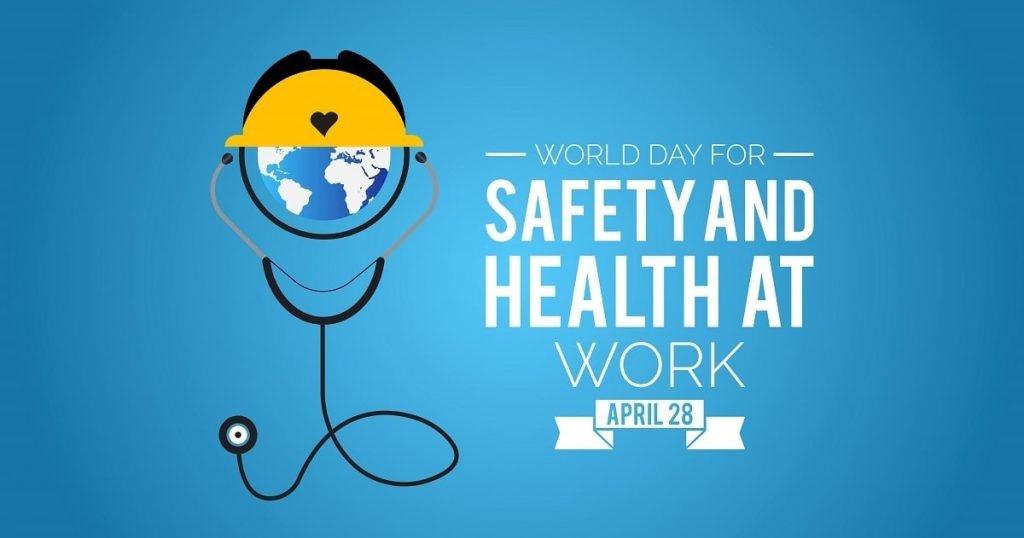Creating a safe and healthy workplace is not just a legal obligation but also a crucial strategy for any successful organization. A physically and mentally thriving workforce is like a well-oiled machine, functioning efficiently and effectively to produce optimal business results. Just as a machine requires regular maintenance to operate at its best, an organization must continuously provide employees with a safe and healthy work environment.
Prioritizing employee health and safety results in a host of benefits, from reduced workplace accidents and fewer sick days to higher employee engagement and productivity. World Day for Safety and Health at Work serves as a helpful reminder for employers to renew their ongoing commitment to workplace safety. By prioritizing the well-being of their workforce, organizations not only fulfill their moral obligation to promote a safe work environment but also invest in their own success.
Organizations can save up to four dollars in workers’ compensation costs for every dollar spent on safety and health programs.
Pressed for time? Here’s a quick summary…
- The Occupational Safety and Health Act of 1970 grants workers the right to a workplace that is safe and free of hazards that could cause harm or death.
- Workplace health and safety is critical to ensure the well-being of employees. Injuries can derail an employee’s health, career trajectory, and overall quality of life while leading to indirect costs and decreased productivity for employers.
- A safe and healthy workplace fosters employee well-being and community, contributes to a positive brand image and company culture, and increases productivity and performance.
- Employers have the responsibility of adhering to safe practices and promoting a healthy work environment year-round.
Workplace Health And Safety 101
Workplace health and safety is critical to ensuring the physical and mental well-being of employees. Health and safety measures include assessing workplace risks and potential hazards, implementing appropriate control policies, and providing sufficient information, instruction, training, and supervision. Employers must also maintain accurate incident records, report accidents as mandated by law, and investigate incidents to prevent future occurrences.

Workplace health and safety programs play a critical role in building a culture of health, which involves prioritizing and promoting healthy behaviors through policies, practices, and norms that support employee well-being. This could include incentivizing regular physical activity and implementing flexible work arrangements.
Importance Of Health And Safety In The Workplace
Every year, millions of workers suffer injuries and fatalities due to accidents that could have been prevented if the proper safety measures had been in place. In 2021 alone, there were over two million non-fatal workplace injuries and illnesses and over 5,000 fatal occupational injuries, increasing nearly 9% from 2020. These shocking statistics highlight the necessity of protecting employees by prioritizing health and safety in the workplace.

Creating a culture of health and safety is essential for fostering a healthy, positive, and supportive work environment. Employers must provide clear communication on policies and procedures, respond quickly to issues raised by employees, and conduct regular training sessions on safety protocols. These key steps ensure workers are comfortable voicing concerns and feel safe at work.
Investing in workplace safety can also help businesses save money. The Occupational Safety and Health Administration (OSHA) estimates that organizations can save up to four dollars in workers’ compensation costs for every dollar spent on safety and health programs. By investing in resources such as training and equipment, employers can keep their employees safe while saving money in the long run.
Impact Of Workplace Injuries On Employees And Employers
The impact of workplace injuries can be staggering, touching every aspect of a company’s operations and an employee’s life.
Impact On Employees
Workplace injuries can be long-lasting and detrimental for employees. Many common injuries, such as overexertion, slipping or tripping, falling from heights, and repetitive motion injuries can wreak havoc on employees’ health, career trajectories, and overall quality of life.

In some cases, these injuries can be severe enough to cause lasting impairments or disabilities. This can dramatically change an employee’s day-to-day realities as they grapple with the uncertainty of job security and the psychological trauma from experiencing an accident.
Impact On Employers
Employers experience indirect costs associated with workplace injuries ranging from four to ten times the amount of direct costs, and sometimes even 20 times higher. These costs include lost productivity, hiring and training replacement workers, loss of business, and administrative time spent processing paperwork.

When an injured employee is unable to work, overall productivity declines, and other team members may have to take on additional responsibilities. This added workload can affect their own job performance and efficiency. Moreover, recruiting and training a new employee can be costly and time-consuming, especially if lengthy induction training is required.
Benefits Of A Safer And Healthier Workplace
Employers that prioritize safety and health in the workplace experience a host of benefits, not only for their businesses but also for their employees’ well-being, morale, and productivity.
- Improves Well-Being: By prioritizing safety in the workplace, employees gain peace of mind knowing their employer is actively working to protect them from harm. Encouraging healthy habits in the workplace, such as eating nutritiously and taking breaks, can prevent illness, reduce stress levels, and optimize all dimensions of well-being.
- Fosters Community: When employees have clear expectations around safety protocols, they’re more likely to stick together in times of crisis or uncertainty. Additionally, building a community around health and well-being can strengthen relationships within the workplace, resulting in a more unified and efficient team.
- Bolsters Human Capital: A safe workplace reduces the likelihood of worker injuries or illnesses, decreasing absenteeism and maximizing productivity. Employees who struggle with physical limitations caused by risky conditions may experience diminished output. Conversely, maintaining a culture of safety and health boosts employee satisfaction, enhances quality of life, and ultimately elevates performance.
- Enhances Culture: Emphasizing workplace safety and health reflects a company’s commitment to its employees’ well-being. Employers can make workers feel valued by clearly communicating standards that promote workers’ safety, encouraging open dialogue about health concerns, and welcoming feedback for improvement. This culture of respect, trust, and support enables peak performance.
- Increases Productivity: By allocating resources to comprehensive training programs, businesses can empower their employees with the knowledge and skills required to appropriately apply safety measures at their work sites. This decreases the likelihood of injuries, boosts productivity, and eliminates the need to repair damaged equipment from misuse. Prioritizing employee well-being is essential for business success, as optimal performance is achieved when employees feel their best.
- Builds Brand: Workplace safety and health are instrumental in constructing a reputable brand image. Companies that prioritize the well-being of their employees demonstrate a commitment to responsible business practices and ethical conduct. This appeals to customers, investors, and potential employees alike, as they often seek organizations that share their values and display care for their workforce.
OSHA’s Role In Workplace Health And Safety
OSHA enforces workplace safety regulations outlined in the OSH Act, which grants workers the right to a safe and hazard-free work environment. Employers must report all work-related incidents to OSHA and comply with its safety standards. The agency inspects workplaces, and if violations are found, it may issue citations or impose fines. OSHA also provides guidance, education, and training materials to assist employers in creating a safe work environment.

In 2023, OSHA will expand its enforcement efforts, including compliance assistance activities, outreach programs, and enhanced inspections of high-hazard industries, to create safer workplaces and increase productivity.
World Day For Safety And Health At Work
World Day for Safety and Health at Work is celebrated annually on April 28th to raise awareness about the importance of occupational safety and health. This global initiative was established by the International Labour Organization in 2003 to promote safe, healthy, and decent working conditions for employees worldwide.

This day underscores the necessity of safety and health in the workplace for both employers and employees, urging governments, employers, workers, and their organizations to promote and implement the best safety practices. The ultimate goal is to reduce work-related fatalities, injuries, illnesses, and disabilities.
5 Ways To Practice Health And Safety in the Workplace
Adhering to safe practices and nurturing a culture of health fosters a secure, healthy, and supportive work environment where employees feel valued and perform optimally. World Day for Safety and Health at Work serves as a reminder for employers to promote workforce well-being—an objective that should be pursued year-round.

1. Before beginning any job or task, employers must provide education on proper safety procedures and policies. Organizing ongoing training sessions ensures employees stay up to date with current regulations and best practices. This also provides an opportunity for workers to voice any concerns or questions they may have about safety in the workplace.
2. Team-building activities foster collaboration among employees, leading to increased productivity and improved morale. They can also strengthen a team’s confidence in handling times of crisis as a unit. Activities may include sports tournaments, game nights, or weekend trips away from work.
3. Encouraging healthy habits not only helps prevent illnesses and reduce absenteeism, but also elevates productivity and performance. Implementing a holistic wellness program that addresses all dimensions of well-being enhances employees’ overall health, improving performance and job satisfaction.
4. Regularly remind staff about safety protocols and health initiatives through posters around the office, social media platforms, or team chats. This can also be incorporated into regular meetings or emails. Raising awareness is an ongoing process, so informing staff on a continuous basis is essential.
5. If a team member often packs healthy lunches for the office, give them a shoutout on social media. If an employee consistently follows safety protocols, gift them with some company merchandise. Rewarding team members who demonstrate healthy and safe behaviors reinforces these practices and encourages others to follow suit.












